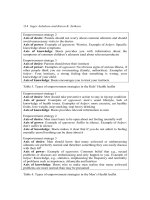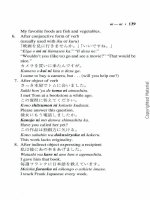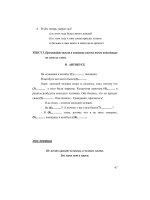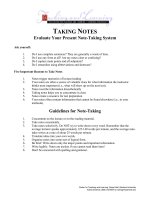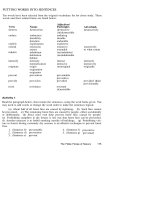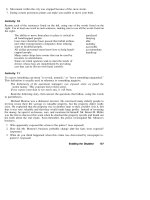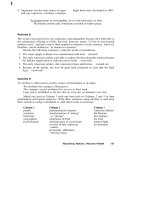LEXIS ACADEMIC VOCABULARY STUDY phần 6 ppsx
Bạn đang xem bản rút gọn của tài liệu. Xem và tải ngay bản đầy đủ của tài liệu tại đây (216.82 KB, 20 trang )
(8) Lighting can also contribute to the narration. Degrees of dark and light can
project a mood of danger, sadness, or romance. Gradually diminishing light at the end
of a scene, called a fade-out in film terminology, serves as a clear transition between
two scenes separated in time. In fact, many narrative devices function to clarify the
time element in movies. Because the events in a story might take place over days,
weeks, or even years, film makers had to create visual devices to express chronology.
Showing the turning hands of a clock or the changing pages of a calendar is one way to
depict the passage of time. In contrast, a film can create the illusion of simultaneous
events by interrupting a scene with other action and then returning to the original
scene. Cross-cutting back and forth between shots of the pursued and shots of the
pursuer is a common technique in chase scenes. Narrative devices such as these make a
film story comprehensible and coherent. That is, they help audiences understand the
sequence of events by combining the separate scenes into a unified story.
(9) As motion pictures improved in the early 1900s, they became increasingly
popular. To keep pace with the public's demand for films, makeshift motion picture
theaters were set up in empty stores and offices, sometimes as many as five to a city
block. For a nickel, theater-goers could see comedy, drama, adventure, and romance
while a piano player provided music appropriate to the action on the screen: touching
music for sad scenes, exhilarating music for chase scenes, and so on. Although inde-
pendent of the film itself, the musical accompaniment enhanced the film narration by
creating a mood.
(10) In fact, music was so critical to screen narration that film makers began exper-
imenting with ways to synchronize recorded music with films. By the late 1920s they
had devised a way to include music on the filmstrip itself. They never intended that
films should "talk," but in The Jazz Singer, the first words in a motion picture were
spoken. Within a few years, all films talked, and films were able to narrate a story not
just with pictures and music, but with dialogue and sound effects synchronized with
the screen action.
(11) Supplementing pictures with sound gave films a richness of new narrative
tools. Like a close-up shot, a sound could focus the audience's attention on something
significant. Sound effects could also reveal the time and place of a scene or create a
mood. For example, a crowing rooster suggested morning in the country, and a howl-
ing wind on a dark night made terrified audiences shiver in fear. Bells rang, crowds
cheered, and guns exploded. But the most significant impact of sound was that actors
could talk.
(12) The addition of dialogue to motion pictures revolutionized not only the way
that film stories were narrated but also the kinds of stories that could be told on film.
Stories that had been virtually impossible to narrate through pictures alone could now
be effectively narrated through pictures and sound. Through dialogue, characters
could reveal critical information about the plot, about themselves, or about other char-
acters. Dialogue could also be used to explain past events or anticipate future action.
The Story of Motion Pictures 97
(13) After films could talk, many popular novels, short stories, and classic literary
works were adapted for the screen. Dialogue from literature was often literally trans-
ferred to the screen version of a story, but descriptions had to be rewritten. If a descrip-
tion could be represented visually, then the camera told the story. If a description could
not be represented visually, then the dialogue told the story. For example, an author
might write, "Distressed that they would miss their airplane flight, Jim and Ann
quickly packed their suitcases and rushed out of the hotel room, not realizing that they
had left their airline tickets on the table."
(14) The filming plan might look something like this:
Scene 27: Interior of hotel room. Time: 14 seconds.
Camera
Action
Dialogue
medium-shot
close-up
fade-out
Jim opens door.
Ann closes suitcase.
They hurry out.
Tickets on table.
Hurry! The plane leaves in
15 mintues!
We've got to make it!
(15) Before the production of a movie can begin, the motion picture director, who
coordinates every aspect of filming, carefully plans each scene in collaboration with
the writer of the screen story. Together they visualize how to divide the story into
scenes and what each scene will contribute to the development of the story. Then the
director establishes a filming schedule, for the scenes are usually not filmed chrono-
logically. As each scene is filmed, the director collaborates with a team of technical
experts, including the lighting technician, the sound technician, the camera operator,
the set designer, and the costume designer. Most important, the director collaborates
with the actors themselves to establish how they will portray their film characters. The
director is guided by an important principle of good film making: every element in the
film—the lighting, the costumes, the dialogue—has a function in narrating the film
story.
(16) After the dozens of scenes are filmed and edited in their final form, sound
effects and mood music are added to the sound track. If the film makers have done their
jobs well, the result will be an entertaining story told through the medium of motion
pictures.
Comprehension Check
The purpose of this activity is to check your understanding of the article and to give
practice using vocabulary words. Label each sentence true or false according to the
article. If you cannot understand the meaning of a sentence, use a dictionary to look up
key words.
1. Thomas Edison's projector made it possible for many people to see live performers
simultaneously.
98 Lexis
2. Actors in silent films would exaggerate their facial expressions to help make the
story comprehensible.
3. The Great Train Robbery revolutionized movie production by being the first film to
employ dialogue.
4. Screen story writers adapt popular novels for the medium of motion pictures.
5. A scene comprises a sequence of events that take place chronologically over days,
weeks, or even years.
6. Silent film makers envisioned films in which actors could reveal critical informa-
tion about the plot through dialogue.
7. Films employ visual devices to depict the passage of time.
8. The illusion of motion is created when a film strip is conveyed through a motion
picture projector.
9. Music can enhance the mood created by film actions.
10. The function of a close-up shot is to focus the attention of the audience on some-
thing amusing in the plot.
UNDERSTANDING
Vocabulary List
Verbs
adapt
comprise
convey
create
depict
employ
enhance
envision
exaggerate
exhibit
focus
perform
project
realize
reveal
revolutionize
WORDS
Nouns
expression
illusion
medium
mood
sensation
sequence
version
Adjectives/
Participles
coherent
comprehensible
critical
dramatic
effective
live
popular
visual
Adverbials
chronologically
literally
simultaneously
Subject-Specific Vocabulary
Nouns: dialogue, film, scene, plot. Adjective: narrative.
The Story of Motion Pictures 99
Activity 1
Circle the one word or phrase that does not have the same meaning as the other three.
1. Early films often (consisted of/contained/comprised/conveyed) one scene that
(showed/depicted/represented/created) a daring rescue.
2. Pioneer film makers (created/invented/performed/devised) new narrative devices
to make film plots more (coherent/visual/connected/unified).
3. Silent film actors had to (express/project/send/adapt) their emotions clearly when
they (acted/exaggerated/played/performed) in a dramatic scene.
4. Film entrepreneurs (imagined/envisioned/dreamed of/developed) recorded music
played simultaneously with the film action.
5. Muted lighting (reveals/adds to/enhances/strengthens) the (emotion/feeling/mood/
plot) in sad scenes.
6. Silent films often (used/employed/adapted/utilized) printed captions between
scenes to make the plots (clear/exciting/comprehensible/understandable).
7. Sound effects can (focus/center/concentrate/reveal) the audience's attention on a
detail that is (critical/important/interesting/essential) to the plot.
8. Through dialogue, film detectives can (expose/explain/discover/reveal) how they
solved a mystery.
9. The first lavish theater built in the 1920s to (convey/exhibit/show/display) motion
pictures was (a cause of excitement/a hit/an expense/a sensation).
10. As a state-of-the-art entertainment medium, television (enhanced/revolutionized/
changed/altered) the entertainment industry and caused a (marked/striking/tem-
porary/dramatic) drop in movie attendance.
11. The approval of film reviewers can be (critical/essential/effective/important) to a
film's success and can (actually/really/virtually/literally) determine its future.
Activity 2
Substitute a word or a form of a word from the vocabulary list for each word or phrase
in parentheses. Be sure to keep the meaning of the original sentences.
Motion pictures do not literally move. The (visual trick) of motion is (made) by
the motion picture projector and the viewer's eye. A motion picture film strip (con-
tains) a (series) of still photographs, each one slightly different from the one it follows.
When the filmstrip is (moved) in front of a rapidly flashing light in the projector, the
pictures in the .photographs appear to move. The (visual trick) of motion also depends
on the physical principle called "the persistence of vision." This means that the eye
retains a (sight) image for a fraction of a second after the view itself has disappeared
and while a new view is appearing. This has the effect of the eye seeing two images (at
the same time). As the images merge, they give the illusion of motion.
100
Lexis
An optical illusion is a visual trick. Here is a well-known optical illusion.
Which line is longer, line A or line B?
Of course they are the same length, but the out-pointing lines at the ends of
В visually extend B, creating the illusion that it is longer than A.
Activity 3
Popular stories are told again and again, sometimes in new versions. For example,
Shakespeare's classic play Romeo and Juliet might be performed in a modern version, а
comedy version, a musical version, a film version, a shortened version, or a foreign
language version. Match each of these terms with one of the descriptions below.
1. The play is adapted for motion pictures.
2. The actors sing their words.
3. The old-fashioned language is changed to present-day language.
4. The dialogue includes many jokes.
5. The words have been translated into another language.
6. Just some of the scenes are included.
Activity 4
Adopt and adapt are frequently confused. To adopt means "to take possession of some-
thing as one's own." To adapt means "to change something to fit a particular purpose."
For example:
The immigrant adapted to Jiving in his adopted ]and.
A coupJe that adopts a baby must adapt to being parents.
Use adopt or adapt in each sentence below.
1. Actors frequently a new name when they enter show
business.
2. Film actors may find it difficult to to acting live on a stage.
3. When you enter a dark theater, it takes a few moments for your eyes to
to the dark.
4. Teenagers often the hairstyles of their favorite rock singers.
The Story of Motion Pictures 101
Activity 5
Verbs of emotion have two adjective forms, one that expresses the cause of the emotion
and one that expresses the emotional effect. For example:
Monsters frighten people, (verb = frighten)
The frightened audience shrieked as the frightening film monster destroyed New
York, (adjectives = frightened/frightening)
In most cases, the cause form ends in -ing and the effect form ends in -ed. Since the
effect is an emotion, it can be used to describe only living beings (usually human),
since only living beings can experience emotions.
Jack fell asleep during the boring movie.
Although the sentence does not say it, we know how Jack felt. He felt bored. The
boring movie caused the emotion. In the article, find the adjective forms of these verbs
of emotion. For each word, tell who felt the emotion and what caused the emotion. The
paragraph numbers are given in parentheses. For example:
engross (paragraph 1)
The audience was engrossed.
The drama was engrossing.
1. fascinate (2)
2. dazzle (3)
3. excite (5)
4. amuse (7)
5. exhilarate (9)
6. touch (9)
7. terrify (11)
8. distress (13)
9. entertain (16)
Not all cause adjectives end in -ing. Check your dictionary for the two adjective forms
of these verbs: impress, scare, delight.
Activity 6
To depict something is to represent it in words or pictures. To perform something is to
do it. To exhibit something is to show it. Use a form of depict, perform or exhibit in
each space below. In some spaces, more than one word may be correct.
The original Superman was a cartoon hero who supernatural
powers and sensational deeds to save the world from evil. The car-
toons him as strong, handsome, and unaffected by the charms of
Lois Lane, a newspaper reporter in love with him. When the Superman stories were
adapted for films, the role of Superman was by several different
actors over the years. Superman's daring deeds had been easy to in
cartoons, but required special effects to on the screen. Like the
original cartoon Superman, the modern film Superman
quiring great strength. But Superman films of today
deeds re-
the hero as
having more human emotions. And for the first time, he reveals his love for Lois Lane.
102 Lexis
Activity 7
1. When a paragraph, a story, or a film is coherent, all of its parts fit together logically
to form a unified whole. Rearrange these sentences into a coherent paragraph.
a. Soon audiences began to recognize the faces of certain actors that they liked.
b. In early films, the names of the actors were not revealed,
с A popular actor virtually assured a film's success.
d. As a result, film makers started promoting their films by advertising the names
of the actors.
2. Add words or phrases to make the paragraph coherent. There are many possible
choices.
Many problems were involved in the production of early sound films.
the camera was so noisy that its sounds were recorded along with
the voices of the actors. the camera was padded with heavy cloth.
the camera became so cumbersome that it literally could not be
moved. not all actors had appropriate voices for sound films.
some had heavy foreign accents or high, squeaky voices.
Activity 8
To enhance something is to make it better or more effective. To exaggerate something is
to make it seem greater than it is in reality.
Black eye make-up exaggerates the eyes.
Muted eye make-up enhances the color of the eyes.
Use a form of exaggerate or enhance in each sentence.
1. Wearing too much make-up facial wrinkles.
2. An appropriate picture frame the beauty of a painting.
3. Realistic art depicts objects as they really are; abstract art often
the size or color of an object.
4. Color film the sense of reality in nature movies.
5. Appreciation of the arts can your life.
To exaggerate (without a following object) means to overstate or
tell more than the truth.
JOHNNY:
Mommy! You should have seen the big
fish
I caught!
It must have been a hundred feet long!
MOTHER:
Johnny, I've told you a million times not to exaggerate.
The Story of Motion Pictures 103
Activity 9
A motion picture comprises several scenes. What do the art forms on the left comprise?
Match the art form with the parts that it comprises. Use a dictionary to look up unfamil-
iar words.
a symphony
a play
a dance
a poem
a comic strip
a novel
Activity 10
cartoons
steps
stanzas
chapters
acts
movements
Science fiction films have depicted many technological and scientific developments
that have later been realized (become real). Which of these creations of science fiction
have been realized?
people journey to the moon in a spaceship
cities are built under the ocean
"robots perform work in factories
doctors transplant human brains
automobiles are equipped with telephones
A more common meaning of to realize is "to learn suddenly" or "to be aware of."
I read half of the book before I realized that I had read it before.
Activity 11
Motion pictures are both a visual art and a performance art. In the list below, put a V
before each visual art and a P before each performance art.
ballet drawing painting
singing sculpture playing the piano
Activity 12
Arrange the following imaginary newspaper headlines chronologically.
TALKING MOVIES POPULAR WITH AUDIENCES
EDISON INVENTS MOVIE PROJECTOR
THE GREAT TRAIN HOBBERY REVOLUTIONIZES FILMS
VIEWING MACHINES ARE NEWEST U.S. SENSATION
INVENTORS ENVISION WAY TO RECORD MUSIC ON FILM
104
Lexis
Activity 13
To convey something has two meanings. One is "to carry something from one place to
another." The second is "to communicate something." Complete each sentence with
an appropriate word or phrase.
convey people from place to place in shopping malls,
convey knowledge to students.
to convey information from one office to an-
1.
2.
3. Businesses use
other.
4. People send
to convey holiday greetings to their friends.
Activity 14 -^
Below is a list of various communication media (the plural of medium). Identify them
in several ways.
cartoon
television
newspaper
1. Which are narrative media?
2. Which are news media?
3. Which are printed media?
4. Which are advertising media?
The term "the media" is used to refer to news media.
poster
stage play
novel
opera
radio
T-shirt
magazine
motion picture
junk mail
Activity 15
Discuss the following questions in pairs or small groups.
1. Two friends see a movie together. When the movie is over, one friend complains
that he did not comprehend the movie. The other says it was completely compre-
hensible to her. What are some reasons why the film could be comprehensible to
her and not to him?
2. What will be the results if each of these is effective: a low-calorie diet, an insect
poison, a speed-reading class, a vacuum cleaner?
3. An advertisement sells a product by focusing on its desirable qualities, such as its
good taste or the beauty that will result from its use. If you were creating an adver-
tisement for a new toothpaste, what would you focus on? Who or what would you
depict in your advertisement?
4. "The fire alarm rang and we rushed out to the school yard. A holiday mood pre-
vailed as we waited for permission to return to our classrooms." How would stu-
The Story of Motion Pictures 105
dents in a holiday mood behave? "The interruption put our teacher in a bad mood
for the rest of the day.'' How would someone in a bad mood behave?
5. Name some inventions of the last 100 years that have revolutionized communica-
tion. Which of these inventions do you think has had the most dramatic effect on
society? Why?
6. What is meant by the expression "One picture is worth a thousand words"?
7. Add a word or phrase that contrasts with the word Jive in the following advertise-
ments or announcements.
Outside a nightclub: LIVE MUSIC EVERY SATURDAY
Music SUNDAY THROUGH FRIDAY
In a market: Live plants $3.95
plants $5.95
On the label of a cassette tape of concert music:
Recorded live.
Recorded
What synonyms are used in the article for the word fiJm, as in the phrase "film
writer"?
What machine, equipment, or instrument is critical to the jobs of each of these
people: a photographer, a chef, a gardener, a physician?
PUTTING WORDS INTO SENTENCES
Ten words have been selected from the original vocabulary list for closer study. These
words and their related forms are charted below.
Verbs
create
criticize
dramatize
effect
affect
envision
visualize
express
Nouns
creator
creation
creativity
critic
criticism
drama
effect
vision
visionary
expression
literature
(il)literacy
Adjectives/
Participles
creative
critical
dramatic
effective
visual
(in)visible
expressive
express
literary
(il)literate
literal
Adverbials
creatively
critically
dramatically
effectively
visually
(in)visibly
expressively
expressly
literally
106
Lexis
Verbs
popularize
sense
Nouns
popularity
sensation
sense
Adjectives/
Participles
popular
sensational
sensitive
Adverbials
popularly
sensationally
sensitively
sensitivity
Activity 1
One meaning of sense is an awareness or feeling. To sense something is to be aware of it
or to perceive it.
We could sense that the audience Jiked the play.
A sensation is also a feeling, but it is usually a bodily feeling rather than a mental or
emotional feeling.
Descending in an elevator gives people the sensation of falling. They have the
sensation of falling.
A sensation can also refer to a person, object, or event of great interest or excitement.
Sensational, the adjective form, has the added meaning "wonderful or terrific."
The Jazz Singer was a sensation.
Al folson was sensational in the starring role.
Change each of the sentences below to include the words sense, sensed, sensa-
tion, or sensational.
1. Movie makers of the 1950s were aware that they needed to create new kinds of
films to lure people away from their TV sets and back to the movie theaters.
2. One attempt to do this was the 3D (three-dimensional) film, which gave audiences
a feeling of reality by creating the illusion of depth in films.
3. Movie-goers could perceive this depth only by wearing special glasses.
4. The first 3D movies were very popular.
5. Audiences felt like they were actually in the movies.
6. The most exciting scenes were those that gave audiences the feeling of motion.
7. This feeling was so real that some people actually became seasick while watching
scenes of boats.
Sensationalism refers to attempts by the media to create public
interest by focusing on shocking subject matter or using shocking
language.
The Evening News depends on sensationalism to sell newpapers.
The Story of Motion Pictures 107
Activity 2
To have a sense of something means "to understand" something, "to be aware" of it,
or "to appreciate" it.
Teachers need to have a good sense of humor. Mr. Reed, however, has no sense of
humor.
Some common phrases of this type are:
a sense of rhythm
a sense of direction
a sense of color
a sense of business
Reword each of these sentences to include a sense of (noun) or no sense of (noun).
The first one has been done for you.
1. Balance is important for dancers.
Dancers must have a good sense of balance.
2. Babies do not understand right and wrong.
3. The President felt he was responsible for the well-being of the country.
4. Artists feel proud when their works are exhibited.
We receive all information about the world through our five senses:
sight, hearing, smell, taste, and touch. Some people claim they
have a "sixth sense" or an "extra sense" that gives them
special powers, such as being able to foresee the future. These
special powers are referred to as Extra Sensory Perception, or ESP.
Activity 3
A sensitive person is one whose emotions are easily aroused, often in a negative way. It
can also refer to a person or a thing that easily detects something. A sensitive topic is
one that can cause uncomfortable emotions.
Don't mention his grey hair. He's sensitive about it.
Bankers must be sensitive to changes in the economy.
Sensitive can also describe a person or thing that exhibits gentle or delicate feelings
about a subject.
On Golden Pond was a sensitive film about the fear of growing old.
Restate the following sentences, using sensitive, sensitively, or sensitivity.
1. Television advertisers may be reluctant to sponsor a program that deals with con-
troversial social issues.
2. If they do sponsor such a program, they may insist that the issue be portrayed
delicately.
108
Lexis
3. Television advertisers are also aware of the kinds of products they can advertise on
television.
4. They know that viewers are very uncomfortable about discussing bodily functions,
for example.
5. Therefore, personal hygiene products must be advertised with great care.
Activity 4
Look up the names of the following devices in a dictionary. Tell what each senses or
what it is sensitive to.
smoke detector Geiger counter
thermostat seismograph
To make sense means "to be logical."
When you're tired, it makes sense to go to bed.
The explanation in the book doesn't make sense.
Common sense refers to thinking or behaving in a practical manner.
Someone with common sense would remember to bring a pencil to an examination.
Activity 5
Restate each sentence, using one of these words: create, creation, creator, creativity,
creative, or creatively.
1. A work of art is something that is much admired for its great beauty.
2. An artist can produce a work of art in music, poetry, photography, architecture, or
in any other art medium.
3. Not all artists' products are works of art.
4. A work of art requires the artist to show inventiveness in the use of his or her
medium.
5. That is, the artist must use the medium in a new and exciting way.
6. The product must be pleasing to the senses.
7. A work of art must effectively project the mood the artist intended to express.
8. Finally, a work of art makes a lasting impression and remains forever beautiful.
The Creator (written with a capital letter) refers to God.
We are thankful to the Creator for the beauty of the world we live in.
The Story of Motion Pictures 109
Activity 6
The relationship between a creator and his/her creation may be stated in either active
or passive form.
Walt Disney created Mickey Mouse, (active)
Mickey Mouse was created by Walt Disney, (passive)
Active forms emphasize the performer of the action. Passive forms emphasize the
result of the action. Sometimes passive sentences do not even name the performer of
the action if the performer is not significant or is unknown.
Mickey Mouse was created in 1928.
Only transitive verbs (those that have a following object) can occur in the passive form.
Notice the verbs below.
The first Mickey Mouse cartoon /ailed because it was a silent film. (Failed has no
following object.)
When the film studio added sound, the next cartoon was a box-office sensation.
(Added is followed by an object, so the sentence can be made passive.)
When sound was added, the next cartoon was a box-office sensation.
In passive sentences, the verb becomes a form of be (is, are, was, were) that agrees with
the sentence subject in number (singular or plural) and expresses the correct tense
(present or past) plus the past participle of the main verb.
The cartoons were drawn in black and white until 1932.
Today Mickey Mouse is known around the world.
Create sentences, using the information below. Do not change the order of the
information, but change the
1. Edgar Allan Рое
2. Tom Sawyer
3. television
4. The Beatles
5. Ernest Hemingway
6. U.S. Civil War
Activity 7
verb tense if necessary,
create
write
invent
popularize
win
dramatize
or make the sentence passive.
short stories and poems
Mark Twain
1920
rock music
Nobel Prize for literature
Gone with the Wind
An expression is an outward representation of an inner feeling. People use words,
pictures, gestures, or other means to express how they feel.
Use the given word to describe these representations of feelings. The first one has
been done for you.
1. thank you (to express)
People say thank you to express gratitude.
2. a kiss (expression)
110
Lexis
3. newspaper editorial (to express)
4. a national anthem (expresses)
Activity 8
Change these sentences to include the words expressive or expressively.
1. Martin Luther King's voice showed his feelings.
He spoke expressively.
He had an expressive voice.
2. Picasso's painting depicted his mood.
3. Charlie Chaplin used his eyes to show his emotions.
4. Рое wrote of his great love in the poem "Annabel Lee."
Activity 9
Express (adjective) can also mean "clear, precise or special." Expressly means "clearly
or especially.'' Change each of these sentences to include express or expressly.
1. Violence is often shown in films for the precise intent of shocking audiences.
Violence is often shoivn for the express purpose of shocking audiences.
Violence is often shown expressly to shock audiences.
2. Cartoons are not made just for children.
3. Movies in the 1950s were filmed in color to compete with black-and-white televi-
sion.
4. Federal laws forbid showing cigarette advertisements on television in the United
States.
Activity 10
Drama refers expressly to narrative forms written for performance on the stage by live
actors. It has come to refer also to any series of events that involve interesting or con-
flicting forces.
Ignoring the politician's speech, the TV camera focused on the drama of the pro-
testors being arrested.
Dramatic or dramatically can refer to something that is done in a theatrical or showy
manner, or something that is bold or striking in effect.
One protestor raised his arms dramatically.
The scene was a dramatic reminder of the political unrest in the country.
The Story of Motion Pictures 111
Dramatize or dramatization means ' 'to represent something in a bold or striking man-
ner" or "to convey an idea through acting."
The scene dramatized the political unrest.
A dramatization of the scene was included in a recent movie.
Rewrite each of these sentences to include drama, dramatic, dramatically, drama-
tize, or dramatization.
1. Live television coverage is able to bring into the home the emotional effect of real
events as they are happening.
2. These events are all the more striking because viewers know the events are real
and not portrayed by actors.
3. Recently, when a two-year-old child was trapped in an underground well, TV crews
rushed to broadcast the daring rescue operations.
4. For seventeen hours the television cameras followed the story of the rescue.
5. The sweat-stained faces of the rescuers boldly showed how hard they were work-
ing to dig the little girl out.
6. The most significant moment was when a man emerged from the hole carrying the
tiny child in his arms.
7. Knowing the TV cameras were on him, he announced with exaggerated emotion,
"She's alive."
Activity 11
Vision (non-count noun) refers to our sense of sight.
As we age, our vision becomes cloudy.
Visions (count noun) refer to mental pictures. To have visions means "to have mental
pictures, usually of something that is not real." Often these visions reflect a person's
fears or secret hopes.
As she began writing her novel, the author had visions of winning the Nobel Prize
for literature.
To visualize something can also mean to have a mental picture of something not real,
but it more often refers to mental images of things that are real.
As the doctor touched the patient's arm, she visualized the bones and muscles
under the skin.
Complete each of these sentences with visualized or had visions of. Explain your
choice.
1. The motion picture director
scene.
a rainstorm ruining his parade
112
Lexis
1
the electrical wiring that would be
the leading actress tearing her dress as
winning an Academy Award for his perform-
the first scene taking place in a dark, old
2. The lighting technician
needed for the lights.
3. The costume designer
she danced.
4. The leading actor
ance.
5. The screen story writer
house.
To envision means "to imagine" and can refer to things that are either real or unreal.
Substitute envisioned in the sentences above.
Activity 12
Visibility refers to the capacity of something to be clearly seen by people.
Bicycle riders should wear light-colored clothing at night to increase their visibil-
ity. They will be most visible in white. Bicycle riders in dark clothing may be
invisible to automobile drivers.
Restate the following sentences to include visible, invisible, or visibility.
1. The paintings of certain 19th-century artists were so smooth that their brush
strokes disappeared.
2. In contrast, Whistler's brush strokes are quite apparent.
3. Obvious brush strokes add texture to a painting.
4. Museums often display a famous painting on a wall by itself so it can be seen
better.
5. Only a trained eye can see the differences between an original painting and a
clever copy.
6. These differences cannot be seen by the average person.
Activity 13
Visual/visually refer to eyesight. Visible/visibly refer to things that are obvious or that
can be seen by others. Compare these sentences.
The man has a visual handicap. (The man's eyesight is poor.)
The man has a visible handicap. (The man has a handicap of some sort that is
obvious to other people.)
The Story of Motion Pictures 113
Use visual/visualJy or visibJe/visibJy in each sentence. In some sentences, more
than one answer is possible.
1. A art is one that can be enjoyed by seeing it, such as painting.
2. The early paintings of Picasso are different from his later
works.
3. Someone once said, "A painting is poetry."
4. Bright colors are more
muted ones.
5. Visitors to the Sistine Chapel in Rome are
magnificent ceiling paintings.
appealing to young children than
impressed by the
Visual aids are items such as pictures, maps, or
charts used in instruction or demonstration.
The teacher used many visual aids to help his
students understand current social problems.
Activity 14
Vision (non-count noun) and visionary refer to the power of creative thought, espe-
cially with regard to the future.
Frank Lloyd Wright was a man of vision. His visionary designs helped shape
modern architecture.
In what ways were the following people visionary?
1. Henry Ford
2. Alexander Graham Bell
3. Wilbur and Orville Wright
Activity 15
The words affect and effect are commonly confused because of their similar spelling
and meaning. Although both have a noun form and a verb form, ajifect occurs most
frequently in its verb form, and effect occurs most frequently in its noun form. To affect
something or to have an effect on something is to is to influence or change something,
often in a negative way. The change or influence is not specifically stated.
Aging affects our hearing.
Aging has an effect on our hearing.
When the result or change is specified, a different form is used.
One effect of aging is (that) our hearing becomes less sensitive.
114 Lexis
Below are several events that happened after sound was added to films. Make
complete sentences by combining one of the phrases below with one of the numbered
events. The first two have been done for you.
One effect of adding sound to film was
Adding sound to film had an effect on
Adding sound to film affected
1. movie attendance
Adding sound to film had an effect on movie attendance.
Adding sound to film affected movie attendance.
2. a dramatic increase in movie attendance.
One effect of adding sound to film was a dramatic increase in movie attend-
ance.
3. the careers of actors with poor speaking voices
4. the popularization of musical movies
5. the need to soundproof filming studios
6. the way film stories were narrated
7. the rapid disappearance of silent films
8. theaters had to add sound equipment
Activity 16
One meaning of popular is "well-liked by many people." Another meaning is "for the
ordinary people."
Rogers and Hammerstein wrote popular music. Their musical play The Sound of
Music was very popular.
Complete the following sentences, using popular, popularly, popularize, or pop-
ularity.
1. One of the most singers in the music field
in the 1950s was Elvis Presley.
2. He introduced a new musical sound that helped rock and roll
music.
3. His great was due as much to his new music as to the rhythmic
way he moved as he sang.
4. Though with teenagers, he was criticized by adults for his
suggestive movements.
5. "Elvis," as he was
of rock music.
referred to, played a significant role in the
The Story of Motion Pictures 115
Activity 17
To criticize something or to be critical of something means "to find fault" with it. A
critic is a person who criticizes.
Adults are often criticaJ of teenage styles.
Teenagers are criticized for their styles.
Read the paragraph, then restate the sentences using the word forms given. You
may need to add words or change the word order to make the sentences logical.
(a) Recently, many old black-and-white films have been colorized to make them
more marketable to television stations, (b) Many people object to colorization because
they say that the black-and-white photography emphasizes the historical nature of the
films, (c) Also, those who are against colorization say that the colorizing process pro-
duces unattractive colors, (d) The producers of colorized films have been accused of
ruining classics for the sake of making money.
1. (Sentence b) critical
2. (Sentence c) critics
3. (Sentence d) criticized
A person who reviews and comments on new films, stage plays,
books, art exhibits, etc., for the media is called a critic.
Although literary critics praised the author's latest novel,
book sales have been poor.
A critique is an evaluation of a literary work or a scholarly
article.
Professors often ask their students to write critiques of
articles from periodicals.
Activity 18
Another meaning of critical is "essential" or "important."
Precise timing is critical when actors perform dangerous movie stunts. Precise
timing is critical to the success of the stunts.
Rewrite each of these sentences to include critical. The first one has been done for
you.
1. Gathering facts is something a newspaper reporter must do as part of the job.
Gathering facts is a critical part of a newspaper reporter's job.
2. The reporters' facts must be accurate in their stories.
3. People's names must be spelled correctly.
4. Reporters must be sensitive when reporting tragedies.
5. A newspaper's reputation depends on careful reporting.
116 Lexis

